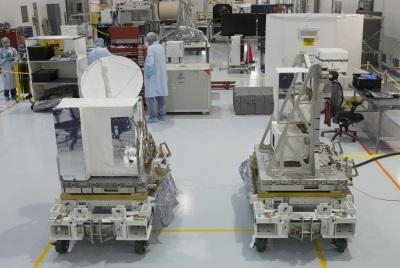Will Measure Ocean Winds From ISS
A new NASA Earth-observing mission that will measure ocean winds from the International Space Station has arrived at NASA’s Kennedy Space Center in Florida to begin final preparations for launch.

The International Space Station (ISS)-RapidScat scatterometer instrument arrived May 12 after a cross-country trip from NASA’s Jet Propulsion Laboratory (JPL) in Pasadena, California. The instrument, built at JPL, now will undergo final tests before being stowed aboard a SpaceX Dragon commercial cargo resupply spacecraft. The Dragon will launch on a SpaceX Falcon 9 rocket from Cape Canaveral Air Force Station, Florida, no earlier than August.
ISS-RapidScat is NASA's first scientific Earth-observing instrument specifically designed and developed to operate from the exterior of the space station. It will measure near-surface ocean wind speed and direction in Earth’s low and middle latitudes during its two-year mission. Its data will be used to support weather and marine forecasting, including tracking storms and hurricanes, as well as climate studies.
Winds over the ocean are a critical factor in determining regional weather patterns and studying climate. High winds in severe storms also can inflict major damage to shore populations and shipping. In some regions, ocean winds drive warm surface ocean waters away from coastlines, causing nutrient-rich deep water to rise to the surface, where they provide a major source of food for coastal fisheries. Changes in ocean winds also help us monitor large-scale changes in Earth’s climate variations, such as El Nino and La Nina.
Since 1999, NASA’s QuikScat satellite, along with satellites operated by international partners, has provided ocean surface winds information for use by the science and operational weather forecasting communities. In 2009, after 10 years of successful operations, QuikScat’s scatterometer instrument stopped providing ocean wind data.
Scatterometers are radar sensors that bounce microwaves off the ocean surface and measure the strength and direction of the echoes that return. The echoes are scattered by the presence of wind-driven waves on the ocean surface. ISS-RapidScat will help fill the gap left by the loss of these data and will extend a 15-year ocean wind climate record.
ISS-RapidScat’s berth on the space station will put it in an orbit that is unique from any other wind-measuring instrument currently in space. This orbit, with an altitude that varies from 233 to 270 miles, will give scientists the first near-global direct observations of how ocean winds vary over the course of the day, while adding extra eyes in the tropics and midlatitudes to track the formation and movement of tropical cyclones. Its 560-mile-wide observation swath creates a map of winds over most of the ocean between 51.6 degrees north and south of the equator every 48 hours.
ISS-RapidScat also will extend the continuity and usefulness of the scatterometer data record from the international constellation of ocean wind satellites. Currently, satellites in the constellation observe at different times of the day. Using the space station’s orbit, it will be possible for ISS-RapidScat to observe areas where the orbits of the other scatterometers in the constellation intersect at the same time. This capacity will allow scientists to correct for previously unknown relative errors between the different wind satellites and extend QuikScat’s 10-plus-year record to create a continuous record.
ISS-RapidScat was developed in just a year-and-a-half, at roughly one-tenth the cost of developing a traditional satellite mission. Its development approach leverages space station capabilities and a combination of new industrial-grade hardware and older inherited hardware used to develop and test QuikScat. Additional cost savings are achieved by launching the instrument aboard a scheduled space station cargo resupply mission.
After arriving at the space station, ISS-RapidScat will be installed on the external payload facility on the Columbus module using the station’s robotic arm. The arm will be controlled from the ground during installation. ISS-RapidScat is an autonomous payload, requiring no interaction from station crew members.
(Image provided by NASA)
 ANN's Daily Aero-Term (04.24.24): Runway Lead-in Light System
ANN's Daily Aero-Term (04.24.24): Runway Lead-in Light System ANN's Daily Aero-Linx (04.24.24)
ANN's Daily Aero-Linx (04.24.24) Aero-FAQ: Dave Juwel's Aviation Marketing Stories -- ITBOA BNITBOB
Aero-FAQ: Dave Juwel's Aviation Marketing Stories -- ITBOA BNITBOB Classic Aero-TV: Best Seat in The House -- 'Inside' The AeroShell Aerobatic Team
Classic Aero-TV: Best Seat in The House -- 'Inside' The AeroShell Aerobatic Team Airborne Affordable Flyers 04.18.24: CarbonCub UL, Fisher, Affordable Flyer Expo
Airborne Affordable Flyers 04.18.24: CarbonCub UL, Fisher, Affordable Flyer Expo



